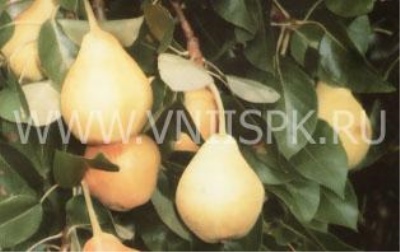
- Authors: Kotov L. A., Tarasova G. N. (Ural Federal Agrarian Research Center of the Ural Branch of the Russian Academy of Sciences)
- Appeared when crossing: Topic x Early Mlievskaya
- Name synonyms: Pyrus communis Zarechnaya
- Year of approval: 2004
- Fruit weight, g: 115
- Ripening terms: early autumn
- Fruit picking time: from 28 August to 12 September
- Growth type: medium height
- Yield: high
- Crown: round, compact, spreading over the years
Pears are some of the nicest trees and fruits to grow on your own. The Zarechnaya variety will also be good. But its features must be carefully studied in order to exclude mistakes.
Breeding history
This plant was developed by the breeders Kotov and Tarasova. They carried out their work on the basis of the Ural Agrarian Research Institute. To obtain Zarechnaya, the Rannyaya Mlievskaya and Tyoma varieties had to be crossed. The official synonym is Pyrus communis Zarechnaya. Pear was entered into the state register of Russia in 2004.
Description of the variety
Key Features:
the formation of medium-sized trees;
round shape of a compact crown;
the gradual growth of this very crown;
compactly located rounded shoots;
dense foliage;
inflorescence of corymbose type;
a large number of flowers;
fruiting on lances.
Fruit characteristics
These are medium-sized fruits of a classic pear-shaped shape, their average weight is 115 kg. The fruit is golden yellow in color. The orange coat is slightly blurred. Signs of rusting are not typical. Moderately thick peduncle reaches medium length.
Taste qualities
The pulp is of moderate density, fine-grained structure. It has a simple sweet taste. The aroma is rather weak. The rind is thin and hardly has a significant effect. Important information:
the share of soluble solids - 11.6%;
the share of sugars - 9.28%;
the content of titratable acids is 0.45%;
sugar-acid coefficient 20.6;
the tasting examination gave an assessment of 4.2 points.
Ripening and fruiting
This variety belongs to the early autumn group. Pears are usually removed from August 28 to September 12. Consumer ripeness can last until October 1. Fruit formation begins in the 4th year of development.

Yield
The variety is considered one of the most effective types of pears. The declared ability to produce up to 125 centners of fruits per 1 hectare. Zarechnaya is also promising for private households.
Growing regions
Such a tree is zoned for the Volga-Vyatka region. In other areas with milder climates, it is conditionally suitable. Landing in more challenging regions has little promise.
Landing
There is nothing complicated in this procedure. You just need to pick up a site with productive soil and prepare a high-quality pit in advance. One-year or two-year-old seedlings are used. In the absence of trace elements in the soil in sufficient quantities, fertilizers will have to be applied. Optimal initial make-up:
50 g superphosphate;
0.1 kg of nitrophosphate;
10 kg of humus (it is not per hole, but per 1 sq. M);
20-25 g of potassium salt.


Growing and care
Watering is especially important for this plant (10 liters per week). In dry periods, it is as relevant as possible, and can even be more active. The shedding of foliage speaks of the drying out and imminent death of the tree. In some cold regions, even in the middle lane, plants will have to be covered. Shelter is required at least along the lower part of the trunk, even for adult specimens.
In the spring, the covering material is removed. In the spring and autumn months, the soil will have to be loosened. Nitrogen fertilizing is applied in early spring in the first 2-3 years. Then they move on to laying down organic dressings. Minerals are added annually, because the Zarechnaya pear will actively pull them out of the soil.
Regardless of the type of fertilizer, they should be laid not at the very root, but in the crown zone. They can be either scattered or placed in shallow grooves. Of the nitrogen compounds, urea is the best for this grade. During the season, up to 5 dressings can be made (both with minerals and organic matter). They are carried out taking into account the peculiarities of the development of culture and the productivity of the soil.



Disease and pest resistance
The pear gall mite hardly attacks such a tree. But sometimes it is affected by other pests. Therefore, it is deliberately unreasonable to do without preventive treatments. Also declared is high resistance to scab damage. Fungal and viral pathologies occur with untimely treatments. Stem rot and powdery mildew are especially dangerous.

Like any other fruit trees, the pear needs protection from various diseases and pests. When planting a pear on your site, you need to know in advance what diseases you should beware of. To successfully carry out the struggle, it is necessary first to correctly identify the cause of the problem. It is important to distinguish signs of disease from manifestations of the presence of insects, mites, caterpillars and other types of pests.
Resistance to soil and climatic conditions
Pear Zarechnaya winter-hardy. However, it is unwise to abuse this ability of hers. Resistance to heat and stress is not characterized in the official description. At the same time, it is known that drought can have an extremely detrimental effect.
Review overview
Growers note the compact development of trees.The annual harvest is pleasantly pleasing. Since the height of the trunks is small, it is not difficult to assemble it. The culture looks quite beautiful - this property is also being paid attention to. The fruits look a little less beautiful than the flowers.





































































